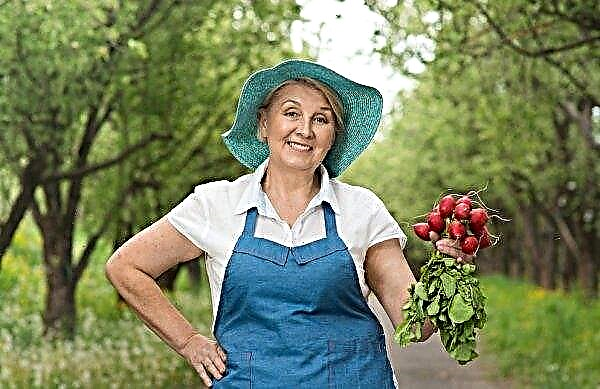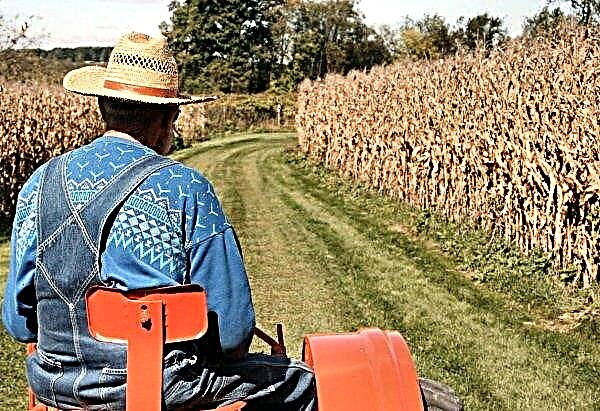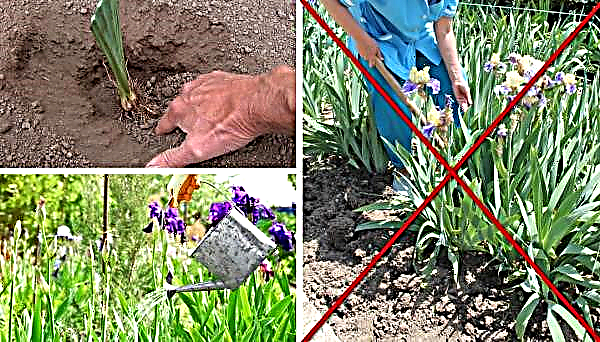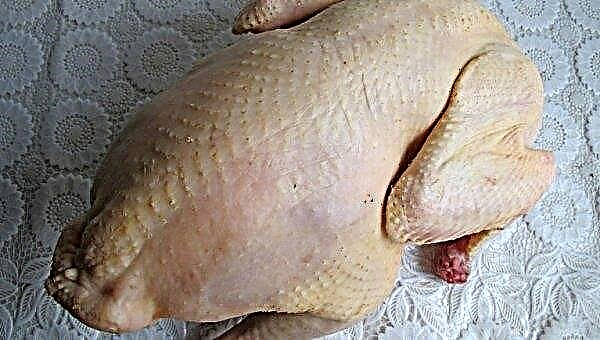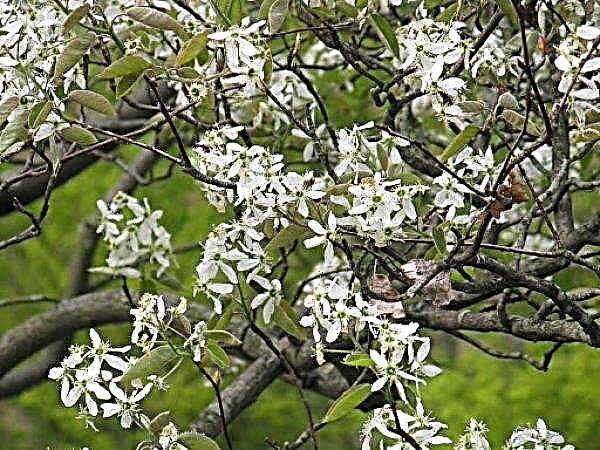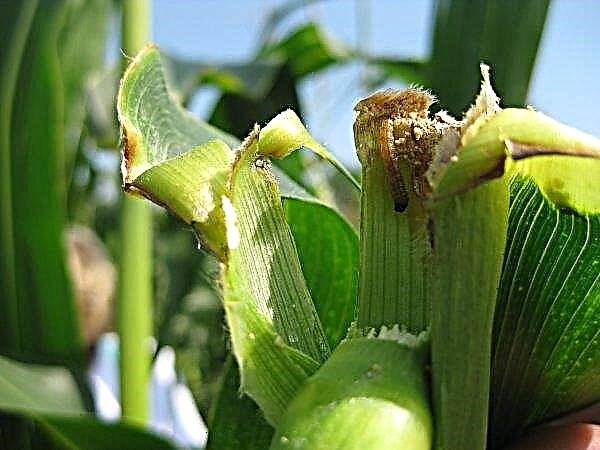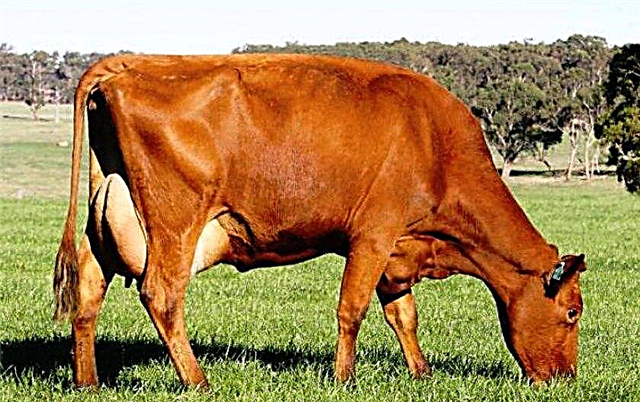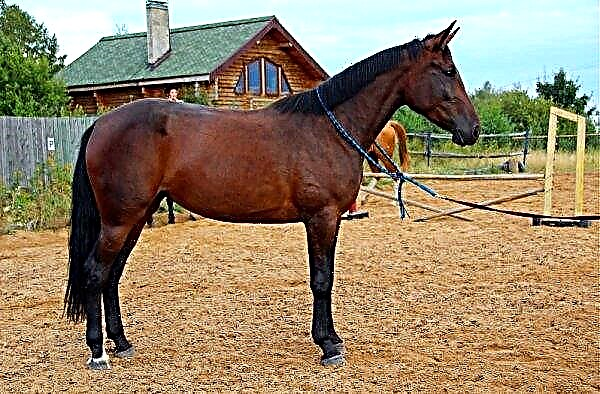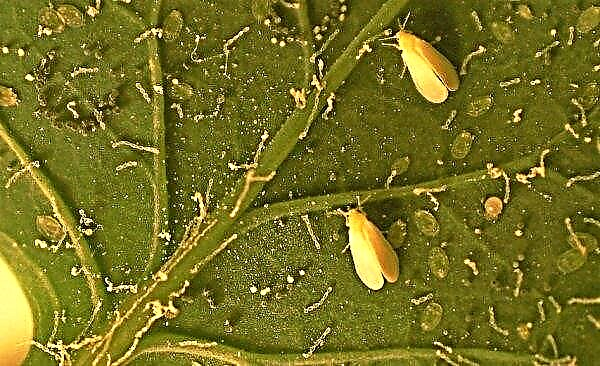Preparation for the main event in the apiary - the honey plant - begins with spring work, the removal of bees, inspection and care for them. It is necessary to approach these procedures responsibly, trying to do everything necessary, without disturbing insects.
Features and stages of care for bees in the spring
Despite the apparent difficulty and responsibility of the spring bee care events, the main thing is to know the procedure and strictly follow it. Following the plan described below, difficulties in their implementation will not arise in the beginning beekeeper.
Exhibition of bees after wintering
Hives are exposed from the winter hut after the air temperature in the shade is at least + 14 ° С. Typically, this weather is set in mid-April - early May. To identify diseases such as varroatosis or nosematosis among the family, it is advisable to send 40-50 bees from each family for examination to a veterinary bacteriological laboratory. Before taking out the hives, the doors are closed, and the hives are insulated with pillows. This should be done carefully so as not to disturb insects.
Did you know? A bee lives from 1.5 to 6 months. A dozen bees in their entire lives are able to collect 1 teaspoon of honey.
When the hives are installed, open the doors (first of the back rows). In order for the bees to remember the location of their own hive, small bunches of straw are placed on the inflow boards. On the same boards rest the gangways, for the convenience of insects getting into the house, after they are emptied from feces. Before hives are taken out, it is necessary to prepare a frame with 3 kg of honey and bee bread for each family. At night, the nest is brought into a warm room so that it does not cool down.
Spring inspection
Activities that make up the spring inspection:
- Frames are carefully inspected, if necessary, replace damaged ones.
- Check the availability and quality of complementary foods - honey.
- Insulation is removed from the hives.
- Open the doors.
- Weak bee colonies strengthen by connecting them together.
- If a weak uterus is found, it is replaced.
If a weak family is found, the hive is insulated to facilitate thermoregulation. At this time, if heating is required, you should either insulate the hive or place a heater in the bottom. It is recommended to equip the heater with a temperature sensor with a circuit breaker, which starts when the hive cools down below + 34 ° С.
Video: first spring bee inspection
Feeding and maintenance
There are times when a beekeeper forgot to inspect the hives for the amount of honey needed for the family to winter. As a result, starvation can begin, which will lead to the death of the family. To avoid this, the family should be fed. The simplest and most effective feeding method is to add honey syrup to the frames with a small amount of honey.
If everything is done correctly, in one frame there should be up to 2 kg of complementary foods, this will be enough for one family for 4-6 weeks. After that, the frame is insulated. A routine inspection involves identifying extraneous insects that can harm bees. In order to avoid an outbreak of nosematosis, it is advisable to add the “Fumagillin” remedy to the lure;
Did you know? One bee family weighs an average of 7–8 kg.
Determining the status of families
The first time to visit bee colonies in spring is better in the early evening, when the street is warm and there is no wind. This is necessary in order to maintain a comfortable temperature in the hive, and the insects do not get angry. The event is carried out in order to determine the sanitary condition of the nest, the strength of the family and the uterus. In addition, you should find out the number of brood, quantity and quality of feed. If the feed is small (less than 4 kg), this will lead to a weakening of the family, and the uterus will not be able to lay a sufficient number of eggs. In order for the bee family to form normally to the main honey plant, it needs a supply of feed - about 12 kg. If frames are found in which honey is spoiled, they are removed, and insects are fed with syrup.
If the feed is small (less than 4 kg), this will lead to a weakening of the family, and the uterus will not be able to lay a sufficient number of eggs. In order for the bee family to form normally to the main honey plant, it needs a supply of feed - about 12 kg. If frames are found in which honey is spoiled, they are removed, and insects are fed with syrup.
The amount of brood is an indicator of the strength of the uterus. The uterus that places the brood non-compactly, or that carries a drone brood, is replaced by another. If nosematosis broke out in the family, there may not be a brood in the combs, although there is a uterus in the nest. In this case, the uterus is removed, and the necessary measures of assistance are applied to the uterine-free family. The condition of the uterus can be recognized by its appearance.
The following signs will tell you that the uterus is young and high-quality:
- the wings are whole, without damage;
- healthy paws;
- the color of the body is lighter than usual, due to integumentary hairs;
- movements are energetic and playful.
Old uterus is darker (hairs fall out) and move noticeably slower. If the uterus is vicious, it has no claws on the hind legs, and the abdomen will be raised. To strengthen the family, such individuals are replaced by young and high-quality ones. In the hive, insects live in the streets - niches between the frames. In the event that the family is located in eight streets, she is considered strong. Families that occupy 6-7 streets of medium strength, those that live on five streets are weak. Only a strong family can bring a lot of honey and other bee products. For each strong family, the beekeeper leaves up to 10 kg of honey and a couple of frames with a feather for food. This will become an incentive to strengthen the laying of eggs by the uterus, and working bees - to abundant spring bribe and raising young animals. In addition, due to the abundant supply of food, the beekeeper will not need to often look into the hive, disturbing insects.
Only a strong family can bring a lot of honey and other bee products. For each strong family, the beekeeper leaves up to 10 kg of honey and a couple of frames with a feather for food. This will become an incentive to strengthen the laying of eggs by the uterus, and working bees - to abundant spring bribe and raising young animals. In addition, due to the abundant supply of food, the beekeeper will not need to often look into the hive, disturbing insects.
Fix weak nests and build up bees
A quality uterus should be in every bee family - this helps to increase the productivity of the entire apiary. If the uterus is weak or if it has died at all, you need to plant a new healthy uterus. In addition, uterine-free families can be interconnected. The uterus is taken from the nucleus and planted in a newly formed family, other individuals are transplanted to neighboring families.
Important! A healthy bee colony needs 2–4 frames; a weak family needs only 2 frames with brood.
Sometimes insects may not accept a new uterus for the reason that the family has a lying uterus: it should be removed from the hive. To increase the bee family, brood and egg laying are used.
Caring for bees in the hives, it is necessary to carry out such events:
- maintain the required temperature in the nests;
- Do not forget to feed the insects so that they normally spend the winter;
- expand bee nests as necessary.
 During the spring inspection, the beekeeper may encounter such a problem: a small number of working insects remained in the hive. A similar situation may arise, for example, after a hot summer, as a result of which, with the onset of autumn, there are few broods left in the hives. The old individuals, loaded with work, remained the winter. With the onset of winter, they fell asleep, but in the spring they no longer woke up. If the hive is very insulated for the winter, and with the onset of the thaw, the insulation is not removed, this can lead to hypothermia in the bee house.
During the spring inspection, the beekeeper may encounter such a problem: a small number of working insects remained in the hive. A similar situation may arise, for example, after a hot summer, as a result of which, with the onset of autumn, there are few broods left in the hives. The old individuals, loaded with work, remained the winter. With the onset of winter, they fell asleep, but in the spring they no longer woke up. If the hive is very insulated for the winter, and with the onset of the thaw, the insulation is not removed, this can lead to hypothermia in the bee house.The increased temperature inside the hive can cause the death of bees. To avoid this, the hive must be properly insulated and ventilated in time. Additional feeding of insects, carried out in the second or third decade of August, contributes to the speedy cultivation of brood. In this case, young growth can grow before winter. In order for the uterus to bee more efficiently, protein (up to 15%) is additionally added to its top dressing, candi, at the end of winter. The presence of complementary proteins stimulates the uterus to oviposition.
Did you know? The first flight of the bee is usually performed during the flowering period of the nut and coltsfoot, in sunny warm weather.
In addition, starting from the last winter month, you must listen to the hives. Based on the sound, the beekeeper draws conclusions about the state of the family: perhaps additional feeding is required. If the sound made by insects is too intense, it is probably hot and the house should be aired. Varroatosis can cause the death of the uterus, instead of it, you can sometimes find a false spoon. It is not only useless, but the presence of this individual can harm the family: offspring should not be expected from it, the family will weaken, the number of working bees will fall. Varroatosis of a bee. If this happens, a new uterus is planted on the family, or the whole family is connected to another, where there is a quality uterus. In addition, there is still such a way: in fortified families that do not have queens, they place frames with eggs and offspring of different ages. Already in May, a new uterus should appear, which will soon be seeded with drones. Uterus, bred in early spring, are highly fertile.
Varroatosis of a bee. If this happens, a new uterus is planted on the family, or the whole family is connected to another, where there is a quality uterus. In addition, there is still such a way: in fortified families that do not have queens, they place frames with eggs and offspring of different ages. Already in May, a new uterus should appear, which will soon be seeded with drones. Uterus, bred in early spring, are highly fertile.
Each apiary conditionally consists of different branches. In one there is reproduction, in the second branch - the strengthening of families, in the third - the collection of honey. The task of the spring preparatory work is to carry out preparatory procedures aimed at strengthening and improving families, preparing them for intensive summer work - collecting honey.
Activities aimed at expanding the territory of the apiary consist of the following procedures:
- in families that need an increase, set 2 frames with a mature brood;
- Transfer frames carefully so as not to touch the uterus. Frames covered with a wax are placed in empty places of prepared nests;
- after the adult bees arrive in the nest, the frame is placed in a new family. If there are larvae in the mother liquor, the uterus and the brood frame are placed in a new house.
Disease Treatment Rules
The most common disease of bees after hibernation is nosematosis. The disease poses a threat to insect productivity and is highly contagious. The disease should be treated only after you are sure that the family is affected by it. First, a visual inspection is carried out, after which up to 50 insects from each family should be sent for analysis to the laboratory.
Prophylactic treatment with antibiotics (“Nosemacid”) is not carried out, it does not make sense and can do harm, yet antibiotics should be used only if justified, and therefore fully confident in the presence of the disease. In addition, the unjustified use of antibiotics is addictive to them, the insect develops resistance to the drug. And when an antibiotic can really be needed, it will be ineffective. For the prevention and treatment of nosematosis, the Apivir drug has proven itself. A herbal preparation whose action is based on the properties of the essential oils of the components that make up the product. In addition to nosematosis, Apivir is used to treat viral, fungal and bacterial infections. The product is added to syrup, candi, an aqueous solution is made with which the hives are sprayed.
And when an antibiotic can really be needed, it will be ineffective. For the prevention and treatment of nosematosis, the Apivir drug has proven itself. A herbal preparation whose action is based on the properties of the essential oils of the components that make up the product. In addition to nosematosis, Apivir is used to treat viral, fungal and bacterial infections. The product is added to syrup, candi, an aqueous solution is made with which the hives are sprayed.
If in the autumn all the work to care for the apiary was carried out correctly, in the spring only the following activities will be sufficient:
- keeping the hives dry and clean;
- proper full feeding of insects (clean frames with feathers);
- creating smaller families.
Varroatosis - a bee tick, is no less dangerous. In the spring, they take measures to destroy it only if the necessary procedures were not performed in the fall. As a preventive measure, Amipol or Fumisan plates are installed. Do this after the spring flyby, so as indicated in the instructions, remove the plates before the first trick.
Important! Formic acid is an environmental and effective means of combating varroatosis, however, the substance in its pure form can harm a person, as it irritates the lung mucosa and skin.
That is, drugs in the hive are active for 4-6 weeks. In order to avoid the development of a tick resistance to one active substance, it is advisable to use other drugs, changing the active substance. The use of formic acid has proven itself well. The listed negative qualities are absent in the Muravinka remedy. The drug is used for the prevention and treatment of such diseases:
The drug is used for the prevention and treatment of such diseases:
- varroatosis;
- nosematosis;
- acarapidosis;
- ascospherosis.
In addition, the drug is used for antiseptic treatment and to combat wax moth. The drug should not be used in case of uncertainty about the presence of the disease, for prevention. It is also not recommended to use it if in the autumn sufficient processing of the bee dwelling was carried out. In the hive in which the treatment is carried out, the upper and lower slots are opened so that normal ventilation is established.
Important! Overdose of "Ants" leads to serious consequences, up to the death of insects, use the drug only according to the instructions. You can not use the product in weak families (5 or less streets).
One package of the drug is designed for a family of 5-12 small streets. The package is placed on the frame, covering it with canvas. The entire course consists of three packages, which are placed in the hive with a frequency of 7 days. In 70–120 hours, the product completely evaporates, and already 40 days after the event, the concentration of the active substance in honey will be minimal. Diseases of the bees.
Diseases of the bees.
Beginner Beekeeper Tips
A few tips will help novice beekeepers in spring care for bees:
- material for insulating beehives must be changed annually;
- for spring removal of hives, special stretchers are used, which not only facilitate removal, but also help to do this without disturbing insects;
- during spring treatment of hives against diseases, do not forget to disinfect and clean them from the inside;
- both in winter and in cold spring, heating can be used to heat hives; insects need it most precisely at this time;
- the higher the temperature in the hive kept in the cold season, the more anxious the insects, respectively, and they need more food;
- spring removal must be carried out on an apiary fenced from the wind;
- if something happened to the uterus, the first flight of insects is sluggish and fragmented, they can just crawl along the board and return home without really flying. Such signs should tell you that there were some problems with the uterus, perhaps she is dead;
- that there is a high probability of an outbreak of nosematosis, prompt defecation of insects on the arrival board and the facade of the hive. Signs of acarapidosis: insects in groups fall out of the letka, crawl (cannot fly up), die with wings spread.
Important! Using additional electric heating, the productivity of one family can be increased by 3 times. This is explained by the fact that insects spend less of their own energy to maintain temperature within the family.
How you care for bees depends on how abundant and high-quality honey you get in the summer. In addition, the health of your pets and the strength of their families depend on proper care.

